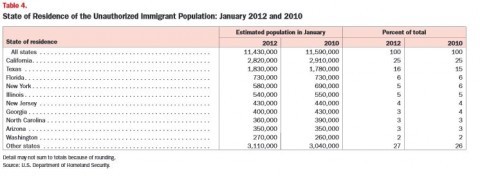7 charts that explain the undocumented immigrant population
By Nia-Malika
Henderson
November 21, 2014 - The Washington Post
President Obama's executive order on immigration could exempt from
deportation more than five million undocumented immigrants -- almost half
of the total undocumented population in the country, which is about 11.5
million (depending on the data you're looking at). The population is vast and
diverse, coming from different countries and living in very different
proportions in different states.
We took a look at some of the demographic breakdowns of the group pulled
together by the Pew
Hispanic Trends Project and the
Department of Homeland Security.
Here is what we found:
1. Illegal immigrants make up 3.5 percent of the U.S.
population

The vast majority of the population has roots in North America --
particularly Mexico and Central America. China, the Philippines, Korea and
Vietnam are among the top 10 countries of origin for the Asian illegal
immigrant population, which has remained stable at 1.3 million -- about 11
percent of all undocumented immigrants.
2. Declining numbers from Mexico
The population of unauthorized immigrants over the last 4 years has largely
flat-lined, remaining stable. Yet the Mexican undocumented population,
which is 52 percent of the total, has consistently declined. Partly it's the
difficult economy, which hasn't fully recovered, and a more secure border. And
President Obama, nicknamed the "deporter-in-chief" by some, has been aggressive
at sending people back to their country of origin -- more than two million to
date.

3. Unauthorized immigrants are settling in the
South
President Obama began the public push for his executive order in Nevada, but
while that state does have a high Latino population and the highest
percentage of illegal immigrants in the country, it doesn't make
the top 10 of states as far as total undocumented population. (Roughly
210,000 undocumented immigrants live in Nevada.)
This list, which is mostly made of blue states, isn't exactly surprising.
Georgia and North Carolina are part of a more widespread Latino population boom
in the South. Relative to the overall population, Latinos -- undocumented and
otherwise -- make up a small share. But their growth is rapid, doubling in some
states in recent years.

4. Well over half of the
illegal immigrant population arrived after 1995
Obama's executive action will cover people who have citizen or legal
permanent resident children who have been here for at least five years, meaning
2009 or before. His move will also expand the time frame use for the Deferred
Action for Childhood Arrivals (DACA) measure to include any children who were
brought to this country illegally before 2010.

5. The population is very young
Back in 2012, during a GOP presidential debate, Newt Gingrich and Mitt Romney
sparred over deporting "grandmothers and grandfathers," zeroing in a demographic
that is actually a very small part of the illegal-immigrant population. Some 80
percent are 44 years old and under, meaning they have a number of working and
childbearing years in front of them. This means an expanded tax base for those
that get work permits, but also means that in some instances people live "off
the grid," while still utilizing school systems and hospitals.

6. Illegal immigrants make up a 5.1 percent of the workforce
Because of that youth, illegal immigrants are over-represented in the
workforce -- 5.1 percent versus 3.5 percent of the overall population.
During his speech
announcing his executive order, Obama made several references to illegal
immigrants roles in the workforce. He talked about "workers who pick our fruit
and make our beds" and "the determination of immigrant fathers who worked two or
three jobs without taking a dime from the government." Dating back to 1995, as
their population rose, illegal immigrants have steadily joined the workforce,
peaking in 2011. The parents of lawful permanent residents and citizens who have
been here for more than five years will be able to apply for work permits and
temporary relief from deportation.

7. 7 percent of k-12 students have an undocumented parent
Another are where the undocumented are over-represented versus their share of
the population is as parents. In fact, 7 percent of non-college students have at
least one parent who is undocumented.
Obama talked a lot about students in his speech, acknowledging "the courage
of students who, except for the circumstances of their birth, are as American as
Malia or Sasha; students who bravely come out as undocumented in hopes they
could make a difference in the country they love." And it's no accident that he
will give his first speech outside of the beltway at a school in Nevada, where
17.7 percent of school children have a parent who is an illegal
immigrant.
